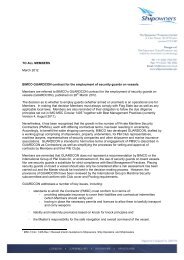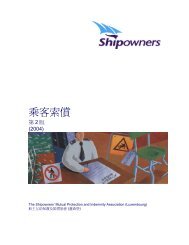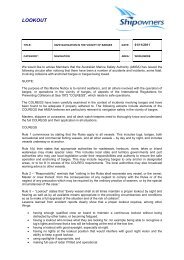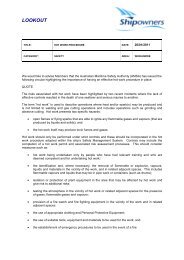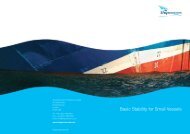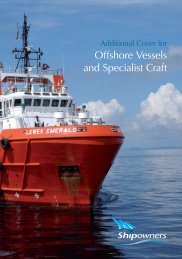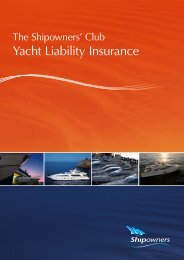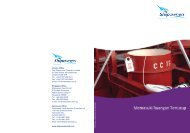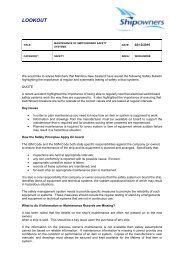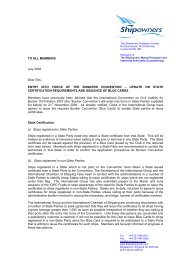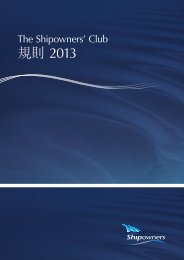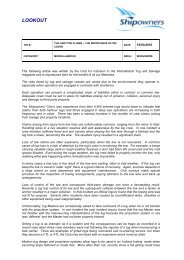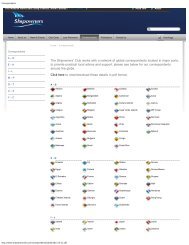Gangways - G angways - Shipowners
Gangways - G angways - Shipowners
Gangways - G angways - Shipowners
Create successful ePaper yourself
Turn your PDF publications into a flip-book with our unique Google optimized e-Paper software.
The <strong>Shipowners</strong>’ Protection Limited<br />
St Clare House<br />
30-33 Minories<br />
London<br />
EC3N 1BP<br />
Tel: +44 (0)20 7488 0911<br />
Fax: +44 (0)20 7480 5806<br />
Email: info@shipowners.co.uk<br />
G a n g w a y s<br />
www.shipownersclub.com<br />
Published April 2008
Contents<br />
2 Introduction<br />
3 General Gangway Assembly and Associated Equipment<br />
– Handrails<br />
– Steps and Platforms<br />
– Illumination<br />
– Lifebuoys<br />
– Safety Net<br />
– Watchman<br />
– Bulwark Ladder<br />
– Fire Plan<br />
9 Double Banked Vessels<br />
10 General Gangway Safety<br />
12 Passenger Vessel Gangway Safety<br />
13 Summary<br />
13 Sources of Information<br />
14 Appendix<br />
1
I n t ro d u c t i o n<br />
The Club has recently dealt with a number of claims involving the access to vessels; some of<br />
which have unfortunately resulted in fatalities. A selection of the incidents encountered by the<br />
Club have been highlighted in the case studies within this booklet (see appendix).<br />
It is important to note that all vessels which are alongside a quay or double banked with<br />
another vessel must provide a safe means of access to enable personnel to access the berth<br />
or other vessel as applicable. The United Kingdom’s Merchant Shipping (Means of Access)<br />
Regulations 1988 No 1637 states “In every ship of 30 metres or more in registered length (or,<br />
in the case of an unregistered ship, of 30 metres or more overall length) the employer shall<br />
ensure that there is carried on the ship a gangway which is appropriate to the deck layout,<br />
size, shape and maximum freeboard of the ship and which complies with the specifications<br />
contained in section 2 of the Code” and “a portable ladder is used for the purpose of access<br />
to the ship only where no safer means of access is reasonably practicable”. Members should<br />
clarify with their local regulations what is individually required e.g. If for smaller vessels there<br />
are no apparent regulations then the onus is still on the master to provide a safe means of<br />
access. It is noted that some national regulations state that the provision of a gangway as a<br />
safe means of access is required no matter what type of vessel or trade it is employed on e.g.<br />
Australian Uniform Shipping Laws Code.<br />
The majority of the Club’s vessels, in view of their size, tend to utilise ladders and g<strong>angways</strong><br />
due to the fact that accommodation ladders tend to be constructed for larger vessels. It<br />
should be noted that g<strong>angways</strong> should have important information marked on their framework<br />
including manufacturers name, safe loading (by numbers and weight), model number and the<br />
maximum angle for the gangway to be set at. If a portable ladder is being utilised this should<br />
be used at an angle of between 60 to 75 degrees (from the United Kingdom’s Codes of Safe<br />
Working Practices for Seamen) from the horizontal and should extend at least 1m above the<br />
final landing place.<br />
General Gangway Assembly<br />
and Associated Equipment<br />
The setting up of an access or gangway (see Figure 1) is an important job and must be<br />
undertaken by a suitably qualified and experienced person from the vessel. The gangway<br />
must not be placed on a bulwark or side rail of the vessel, unless the bulwark or side rail is of<br />
sufficient strength to bear the weight of the gangway and persons using it. Relevant<br />
equipment must also be available as follows:<br />
1 Handrails – These should adequately fence off the ladder and be kept at 1m in height. If<br />
these are made of rope they must be monitored and kept taut at all times.<br />
2 Steps and Platforms – Must be kept clear of oil and debris. If a bottom platform is fitted on<br />
the gangway, this must be kept horizontal and have stanchions fitted to enable the safety<br />
rope to continue through them.<br />
Figure 1: A typical set up of a gangway<br />
2 3
3 Illumination – The access area of the vessel, the total length of the gangway and the<br />
quayside is to be kept adequately lit to ensure safe transit.<br />
4 Lifebuoy – This must be fitted with a separate safety line attached to a quoit or similar<br />
device and a self igniting light. This must be positioned on the vessel at the top of the<br />
access point.<br />
5 Safety Net – If it is applicable and practicable a safety net is to be fitted under every part of<br />
the access ladder or gangway extending on both sides and kept taut. The net must not be<br />
secured to any fixed point on the quay. Figures 2 and 3 show g<strong>angways</strong> incorrectly rigged<br />
therefore increasing the risk of incidents. Figure 4 shows a correctly rigged gangway, with<br />
access ladder, security point, security notices and the permanent presence of a watch keeper.<br />
Figure 4: A correctly rigged gangway<br />
Figures 2 and 3: Means of access incorrectly rigged<br />
4<br />
5
6 Watchman – Even if it is not applicable under local regulations for some vessels to<br />
comply with the ISPS Code, it must be borne in mind that it is good practice to have a<br />
member of the vessel’s crew permanently stationed at the gangway for safety purposes.<br />
They will be able to assist persons transiting the gangway as required and to monitor<br />
any dangerous practices. The watchman must keep in mind that he is the first point of<br />
contact on the vessel for the boarding person. If a vessel is alongside a berth affected<br />
by tidal conditions, constant reassessment of the situation should be carried out. In<br />
addition the watchman must have access to the times of high and low waters and be<br />
aware of any cargo operations which may affect the vessel’s trim. If a watchman is not<br />
present at the gangway and an incident occurs, the vessel’s crew may carry on with<br />
their duties unaware of the situation.<br />
7 Bulwark Ladder – These should be<br />
utilised when the top of the gangway or<br />
portable ladder rests or is level with the<br />
bulwark. It should be securely attached<br />
to the vessel to prevent movement and<br />
must be equipped with 2 rigidly secured<br />
handrails / stanchions. Figure 5 shows a<br />
bulwark ladder in use but as highlighted<br />
is incorrectly secured to the vessel by<br />
using its goose neck vent.<br />
Figure 5: Gangway incorrectly secured<br />
to the vessel<br />
8 Fire Plan – This is placed in the vicinity of<br />
the gangway and contains information<br />
that may be useful in an emergency e.g.<br />
cargo stowage plan, stability details,<br />
crew list, General Arrangement plan and<br />
a plan highlighting the location of<br />
vessel’s safety equipment etc ...<br />
In addition, prevailing circumstances e.g.<br />
weather and events, which may create<br />
temporary tripping hazards must be taken<br />
into account and highlighted as necessary.<br />
When assembling an access it is not only<br />
the vessel’s equipment, access and<br />
procedures that need to be assessed and<br />
followed but also those ashore. It should be<br />
ensured, as far as possible, that the end of<br />
the ladder being located on the quay is<br />
placed in an unobstructed area clear of<br />
debris and oil patches and is away from<br />
impending dangers such as lorries / cranes<br />
for cargo work and cargo being loaded /<br />
discharged.<br />
Figure 6: A typical fire plan located in the<br />
vicinity of the vessel’s access<br />
Figure 7: A gangway rigged taking into<br />
account the shore side hazards e.g. mooring<br />
bollards and crane track<br />
6<br />
7
Double Banked Ve s s e l s<br />
After the access has been rigged and prior to use, the gangway should be checked to ensure<br />
that it is safe to utilise.<br />
Areas to concentrate on include:<br />
! Cleanliness<br />
! Faults, including physical damage. All boarding equipment should be maintained and<br />
checked at regular intervals designated by a planned maintenance programme. Any<br />
faults which are noted on the equipment must be dealt with immediately and in a fully<br />
approved manner. Aluminium equipment should be particularly checked for corrosion<br />
and ladders should not be painted in case this conceals defects<br />
! All moving parts are in good working order and are well greased<br />
! All associated equipment is available and correctly located<br />
It should be noted that when vessels are double banked (i.e moored alongside each other)<br />
the vessel which is outboard will normally set up the equipment to the other vessel although,<br />
in cases where the freeboard differs greatly, access should be provided by the vessel with the<br />
greater freeboard.<br />
F i g u re 9 : A c re w m e m b e r l e a p i n g f ro m o n e v e s s e l t o a n o t h e r a s n o c o rre c t m e a n s o f access is rigged<br />
Figure 8: Gangway in need of maintenance<br />
Figure 10: Incorrect access between<br />
two vessels<br />
Figure 11: Correctly rigged gangway<br />
between double banked vessels<br />
8<br />
9
General Gangway Safety<br />
To assist with safety, signs can be erected to notify the person boarding the gangway of any<br />
dangers or problems that may occur when transiting or alighting onto the vessel or quay.<br />
Please see Figure 12 issued by Transport Canada. This highlights the importance of using the<br />
designated means of access.<br />
Safety Signs<br />
Working Safely<br />
Never jump. Always use the gangway or ladder<br />
when boarding or leaving the vessel.<br />
Figure 12: Safety sign issued by<br />
Transport Canada<br />
The Club has also issued a passenger safety card (Figure 13) which highlights the need for<br />
using the gangway.<br />
Signage can also highlight connected safety procedures such as:<br />
! Maximum number of persons on the gangway at one time<br />
! The good practice of not carrying too much whilst on the gangway. This enables<br />
the person to leave a hand free to hold onto the handrail.<br />
It is preferable for g<strong>angways</strong> to be fitted with a non-skid surface. Some are constructed<br />
using gratings with this in mind but others are not. Ways in which this can be rectified is by<br />
applying non-skid paint or by using a system which can be added to an existing gangway.<br />
When the gangway is in use it is extremely important that the maximum allowable number of<br />
people using the gangway does not exceed the permitted limits. This is reiterated in Case<br />
Study 3 (see appendix) where the excessive amount of persons on the gangway caused a<br />
harmonic movement which resulted in the bottom of the gangway shifting clear of the quay,<br />
throwing the men boarding at the time into the water. This unfortunately resulted in a fatality.<br />
As per Case Study 2 (see appendix) some claims occur when people get their feet caught<br />
under the wheels or roller at the end of the gangway as the vessel surges. This can be<br />
prevented by fitting a metal plate onto the end of the gangway. This will push the person’s<br />
feet away as the vessel surges without restricting the movement of the rollers/wheels.<br />
Figure 13: Illustration taken<br />
from the passenger safety<br />
card issued by the Club<br />
10<br />
11
Passenger Vessel Gangway Safety<br />
On passenger vessels, it is imperative for their crew to remember that they are the first point<br />
of contact for boarding passengers and they give a first impression on how the vessel is<br />
managed. Passengers may not be familiar with the vessel and its potential dangers and<br />
therefore the importance of a designated crew member standing by at the boarding area to<br />
assist, advise and instruct is essential.<br />
Prior to the commencement of embarking / disembarking operations it is important for the<br />
crew members concerned to assess the boarding area for any potential problems e.g. the<br />
requirement to rope off unguarded areas around gangway as shown in Figure 14 (this<br />
highlights an unprotected area existing between the gangway and vessel’s railings that should<br />
be roped off accordingly).<br />
When the passengers are embarking / disembarking, designated crew members for gangway duty<br />
should be assertive and patient, taking into account any special requirements of the boarding<br />
personnel e.g. passengers with physical disabilities. They should remain on duty throughout<br />
their watch and not proceed to leave their position until relieved by a fellow crew member.<br />
S u m m a ry<br />
It should be noted that flag states, governing authorities and ports may differ to the<br />
advice given in this publication, but the issue of ensuring safe access onto a vessel is a<br />
combination of good seamanship and common sense and therefore all available<br />
measures must be taken to ensure that cases like those highlighted in this booklet do not<br />
reoccur.<br />
Sources of Information<br />
1 The United Kingdom’s Codes of Safe Working Practices for Seamen<br />
2 The United Kingdom’s MAIB case reports<br />
3 The United Kingdom’s Merchant Shipping (Means of Access) Regulation 1988,<br />
Statutory Instrument 1988 No. 1637<br />
4 Transport Canada<br />
Responsibilities of the crew members should be included in the vessel’s working procedures<br />
and referred to as necessary.<br />
Figure 14: The area between the gangway and vessel’s railing left unguarded<br />
12<br />
13
Appendix<br />
A p p e n d i x<br />
Case Study 1<br />
This incident involves an injury to an elderly lady passenger disembarking from a tourist craft<br />
operating in north eastern Australia. The craft itself was of unusual construction, being a semisubmersible<br />
vessel which was designed to allow passengers to view coral reefs through<br />
windows in the lower deck below water level.<br />
The incident occurred after the vessel had returned to the dock. The passenger and her<br />
husband had not disembarked with the main body of passengers as they had remained on<br />
board to search for a lost piece of camera equipment. Having found the missing item they<br />
ascended to the main deck and moved towards the gangway. To do so they had to negotiate<br />
a change in level on the upper deck where there was a 27cm step. In doing so the lady<br />
stumbled and fell, severely breaking her ankle.<br />
Observations<br />
The raised section of the upper deck was covered to within 6cms of the step by a black<br />
plastic mat. The lower level and the 6cm strip along the edge of the higher level was painted<br />
with white non-skid paint. The result was that the edge of the step was difficult to detect visually.<br />
There were no handrails and no warning notices or other visual warnings. Although crew<br />
members had been assigned to assist passengers at the gangway close by, none were<br />
assigned to assist passengers who negotiated the step.<br />
This accident should never have been allowed to happen. Our investigations revealed that crew<br />
members assigned to the gangway had observed passengers stumbling on the step on<br />
numerous occasions. If the company had implemented a safety management system the crew<br />
members would have a means of reporting their observations and appropriate measures could<br />
then have been taken to minimise the risk to passengers. Those measures could have included<br />
painting the edge of the step in high visibility paint of contrasting colour, placing appropriate<br />
warning notices in the vicinity, fitting a handrail and stationing crew members to assist frail<br />
passengers in negotiating the change in level. Alternatively it might have been possible to<br />
replace the step with a ramp.<br />
14<br />
15
Appendix<br />
Case Study 2<br />
This incident arose on board a harbour ferry operating in smooth water. The harbour ferry<br />
was fitted with hydraulic ramps designed for the embarkation or disembarkation of<br />
passengers. The ramps had been lowered to enable passengers to board the vessel and<br />
having been positioned hydraulics were ‘locked’. Shortly after passengers started to board<br />
another vessel backed into an adjacent wharf creating some wash. The combination of that<br />
wash and wave actions in the harbour caused the ferry to surge and roll. The movement<br />
resulted in the hydraulic ramp fitted to the ferry rising a few inches up off the connecting<br />
hydraulic ramp fitted to the jetty. When the vessel rolled back a passenger's foot was<br />
trapped between the ramps.<br />
Observations<br />
Surprisingly the claimant's lawyers did not argue that the ramp was unsafe because it did<br />
not hinge. Instead they concentrated on the fact that the wharfhand on duty had been<br />
preoccupied with tying up another vessel when the accident occurred and that the ramp<br />
was unattended. Plaintiff's lawyers alleged that had the crewman been at his place of duty<br />
he could have warned passengers of the danger and prevented them from boarding until it<br />
was safe to do so.<br />
While there were considerable doubts about whether the presence of a company employee<br />
would have had any material effect on the incident, our lawyers advised that the simple fact<br />
that the Member did not have an employee on the spot overseeing the boarding process<br />
would almost certainly have led the courts to the conclusion that our Member had not<br />
discharged their duty of care to the passenger. This illustrates the high standards that are<br />
expected from the operators of passenger vessels carrying the general public and the levels<br />
of care which they are expected to maintain.<br />
16 17
Case Study 3<br />
N o t e s<br />
A total of 16 shore contractors arrived at the ship and started to embark via the ship's<br />
gangway. When the parties were on the gangway, a harmonic movement caused the bottom<br />
of the gangway to shift clear of the quay. The gangway then dropped until held by its own<br />
wires, which had been left slack to allow for movement during cargo operations. This sudden<br />
movement caused 3 of the contractors to be thrown from the gangway; one managed to hold<br />
on to the safety net, but the other two went into the water. One of the men in the water swam<br />
to safety, the other drowned.<br />
Investigation into the accident by the ship and company identified the following contributory<br />
factors:<br />
! the gangway was not fully rested on the quay (10cm only) because of the limited area<br />
between the quay edge and a gantry crane being used for cargo operations;<br />
! the distance between the ship and the quay was excessive (2.4m) due to the<br />
fendering arrangements in place;<br />
! the number of persons using the gangway simultaneously (16) exceeded the<br />
maximum allowed (10) causing a harmonic motion;<br />
! the sign indicating the maximum number of persons was placed at the top of the<br />
gangway; and the designated watchman was not proactive in controlling the use of<br />
the gangway.<br />
Corrective actions identified by the company included:<br />
! ensuring that a sign is placed at the base of g<strong>angways</strong> detailing the maximum<br />
persons allowed; limiting the maximum number of persons using a gangway to three<br />
when it is not possible to place the gangway firmly on the quay and it is being<br />
supported by its hoisting wires only;<br />
! extra vigilance and proactive management of g<strong>angways</strong> by watchmen, and where<br />
necessary their positioning at the top or bottom of the gangway to effect maximum<br />
control over shore gangs embarking or disembarking.<br />
This Case Study was kindly provided by the Maritime Accident Investigation Bureau (MAIB)<br />
18 19
N o t e s<br />
20



